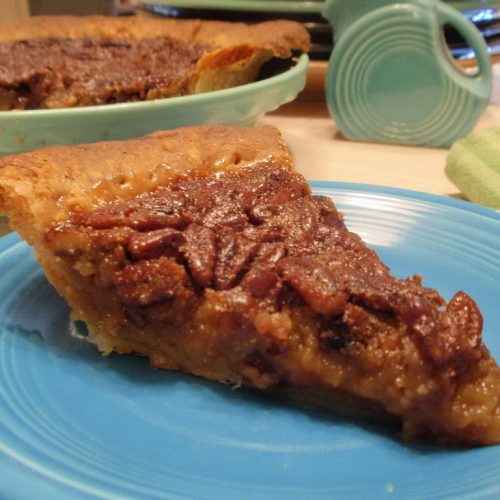There is a heartwarming nostalgia to Southern baking, and standing proud as one of its most beloved creations is the Pecan Pie. Nestled within this baking tradition, you will find an old-fashioned delight, the New Orleans Pecan Pie, a dessert that is as quintessentially Louisiana as it gets. The pie, with its decadent filling and buttery crust, captures the essence of Southern comfort in each slice.
In Louisiana’s vibrant food scene, the Old Fashion New Orleans Pecan Pie holds a special place, hailed as the king of pies. Its roots are intertwined with the state’s rich history and culture, adding to its unique charm. Unlike its modern counterparts, this pie harks back to a time before corn syrup dominated the baking scene. The authenticity of its flavors stems from its traditional recipe, which calls for darker sugar-based syrup or molasses, enriching the pie with a deeper, more complex sweetness.
This pie is not just a dessert; it’s a celebration of Southern heritage. Every bite into the pie’s crumbly crust reveals a rich filling, punctuated by the crunch of pecans, resulting in a symphony of textures and flavors that is soul-satisfying. The Old Fashion New Orleans Pecan Pie serves as a reminder of the simple joys of baking and the magic that happens when timeless recipes are passed down through generations.
Table of contents
Exploring Diverse Interpretations of Classic Pecan Pie
The world of culinary creativity thrives on reinvention and nowhere is this more evident than in the various interpretations of the classic pecan pie. A traditional staple of Southern American cuisine, pecan pie lends itself beautifully to a range of inventive variations, each adding a unique twist to this much-loved dessert.
The Chocolate Pecan Pie, for instance, marries the nuttiness of pecans with the decadent allure of chocolate. This variation involves either blending semi-sweet or dark chocolate chips into the pie filling or creating a rich chocolate layer on the pre-baked crust. The result is a harmonious balance between the pecan’s distinctive crunch and the velvety smoothness of chocolate.
Another intriguing twist on the classic is the Bourbon Pecan Pie, where a generous splash of bourbon adds a sophisticated depth to the pie filling. The bourbon introduces rich caramel undertones and a hint of smokiness that elevate the pie to new gourmet heights. Meanwhile, the Salted Caramel Pecan Pie offers a tantalizing sweet-salty interplay, achieved by drizzling salted caramel atop the pecan filling. This creates a flavor contrast that simultaneously surprises and delights the palate. Through these diverse interpretations, the classic pecan pie continues to reinvent itself, offering a tantalizing treat for every dessert lover.
Effective Strategies for Preserving Your Homemade Pecan Pie
Storing a homemade pecan pie properly ensures that it maintains its delicious flavor and texture. Once you’ve baked and cooled your pie, consider if you’ll be serving it immediately or storing it for later. If you plan to serve your pie within a few hours, simply keep it at room temperature, covering it with a clean kitchen cloth to protect it from dust or insects.
For longer storage, refrigeration becomes necessary. To refrigerate your pecan pie, first allow it to cool completely at room temperature. This step helps prevent condensation, which could make your crust soggy. Once it’s cool, wrap the pie securely in plastic wrap or aluminum foil to protect it from absorbing any other flavors in your refrigerator. A properly stored pecan pie can stay fresh in the refrigerator for up to four days.
For even longer storage, pecan pies can be frozen. To freeze your pie, cool it completely at room temperature before wrapping it tightly in several layers of plastic wrap and then a layer of aluminum foil. This method prevents freezer burn and maintains the pie’s quality for up to two months. When you’re ready to serve your frozen pie, thaw it in the refrigerator overnight, then allow it to come to room temperature before slicing and serving. Following these steps will ensure your pecan pie remains as fresh and flavorful as possible, whether you serve it immediately or save it for a special occasion.
Unraveling the Sweet History of Pecan Pie
The tale of the pecan pie is deeply intertwined with the culinary heritage of the southern United States. Originating from this region, pecans have held a place of importance for more than 8,000 years, as per archaeological evidence found in Texas. Native American cultures have long relied on this versatile nut for sustenance. However, while these indigenous groups had mastered the art of flatbread using cornflour for approximately 10,000 years, the inclusion of wheat – essential for a classic pie crust – was not yet a part of their repertoire. This ingredient only made its way to the Americas with the arrival of Europeans.
The encounter between the Old World and the New brought together the key ingredients that would eventually form the pecan pie we know and love today. It’s highly likely that Native Americans were the first to concoct pastries filled with pecans, but the marriage of pecans and wheat for pie crust could not take place until this cross-continental exchange occurred. History suggests that it was the French settlers in New Orleans who first developed what we’d recognize as pecan pie today, inspired by the pecan nut introduced to them by the Quinipissa and Tangipahoa Native American tribes.
Tracing the specific origin of pecan pie yields a pivotal reference in Harper’s Bazaar in 1886, which published a recipe for pecan custard pie. This is the earliest known recipe that closely resembles the modern pecan pie, marking a critical point in the dessert’s history. Regardless of its precise origins, one undeniable truth remains: the pecan pie, with its rich, sweet filling and crunchy nut topping, is a universally cherished delight. Through the ages, it has cemented its place as a staple of Southern cuisine and a symbol of culinary fusion.
The Vibrant Metropolis of New Orleans, Louisiana
Nestled along the Mississippi River and close to the Gulf of Mexico, New Orleans is a bustling city renowned for its vibrant culture and significant economic impact. It serves as a crown jewel of Louisiana, boasting a population of 383,997 as per the 2020 U.S. census, making it the state’s most populous city. Each corner of this city hums with life, reflecting a unique blend of cultures and histories that shape its identity.





New Orleans’ strategic location along the river and its proximity to the Gulf endow it with a significant role in the United States’ economy. The city hosts a major port, acting as a vital access point for maritime trade. This advantage has allowed New Orleans to develop into a prominent commercial center, influencing the broader Gulf Coast region’s economic dynamics.
Despite being a business and commercial powerhouse, New Orleans also holds a charming allure. The city’s bustling streets, historical architecture, lively music scenes, and culinary delights together form an enchanting blend that attracts both tourists and entrepreneurs alike. This unique combination of economic vitality and cultural richness truly sets New Orleans apart, marking it as a remarkable metropolitan city in Louisiana.
The Founding Journey of New Orleans: A Brief History
In the vibrant spring of 1718, La Nouvelle-Orléans, now known as New Orleans, was born. Under the determined direction of Jean-Baptiste Le Moyne de Bienville, the French Mississippi Company founded the city. Although the exact founding day remains elusive, tradition has long held May 7 as the anniversary of this momentous occasion. The site chosen for the city was not uninhabited wilderness, but land previously occupied by the Chitimacha people, reflecting the layers of culture and history inherent in this region.
The city owes its name to Philippe II, Duke of Orléans, who held the position of regent of the Kingdom of France at that time. Naming this new city after him was more than a mere gesture of loyalty; it was a bold statement, connecting this budding outpost in the New World with the grandeur and prestige of the French monarchy. This was a calculated move by the French Mississippi Company, aiming to establish their city as a beacon of French influence in the increasingly contested landscapes of North America.
The Duke of Orléans, however, did not draw his title from a self-styled creation, but from the venerable French city of Orléans. This further deepened the connection between the newly founded New Orleans and the rich heritage of French culture. This connection has endured through the centuries, with New Orleans retaining a distinctly French character long after it became a part of the United States. This French influence, blending with other cultural streams, has helped shape the unique, vibrant character of New Orleans as we know it today.
Unleashing the Vibrancy: Tourism in New Orleans
The city of New Orleans, fondly known as the “Big Easy,” is a magnet for tourists worldwide, drawn in by its enticing blend of culture, history, and an electrifying nightlife. The city never seems to sleep, with its vibrant live-music scene reverberating through the streets round-the-clock. From the sultry notes of jazz and blues to the lively beats of zydeco, the music of New Orleans is as diverse and dynamic as the city itself.
One of the city’s most famous events is Mardi Gras, a late-winter carnival that has become a global icon for its unabashed exuberance. It’s during Mardi Gras that New Orleans’ festive spirit truly shines, with lively, costumed parades, spirited street parties, and a communal atmosphere of joy and camaraderie. Visitors from around the world converge on the city during this time, eager to experience the unique flavor of Mardi Gras in the city where it takes on a life of its own.
Aside from its vibrant festivals and music scene, New Orleans offers an array of experiences that continue to captivate its visitors. The city’s historic neighborhoods, particularly the enchanting French Quarter, serve as living testaments to its rich past, while its array of museums offers deeper insights into its multifaceted history. Every visit to New Orleans offers the promise of a new experience, a new story, and a new appreciation for this one-of-a-kind city.
The Unique and Influential Cuisine of New Orleans
The world-acclaimed cuisine of New Orleans stands as a testament to the city’s rich cultural heritage and diverse influences. Distinctive and influential, it’s an edible narrative of the city’s history and its various cultural intersections. This delicious blend of local Creole, Haute Creole, and New Orleans French cuisines offers a gustatory experience that is as multifaceted as the city itself.
A myriad of traditions converge in New Orleans’ culinary scene, each adding their unique flavors and cooking methods to the mix. The influence of French, Spanish, and Italian cuisines is discernible in many dishes, while African, Native American, and Cajun traditions further deepen the culinary complexity. Hints of Chinese and Cuban cuisines also make their presence felt, contributing to the bold, easily recognizable New Orleans flavor profile. Local ingredients take center stage in these culinary creations, reflecting the city’s strong connection to its surrounding land and waters.
These diverse influences can be savored in every bite of New Orleans’ food, from savory gumbos and jambalayas to sweet beignets and pralines. But to truly appreciate the city’s culinary tradition, one must delve into the world of its local bakeries, where the fusion of flavors continues to delight locals and tourists alike. One such place is Windowsill Pies, a local bakery that masterfully brings together the distinct tastes of New Orleans in their delectable range of pies. Next, we’ll take a closer look at this beloved bakery and how it encapsulates the city’s unique culinary spirit in each of its creations.
– Featured Bakery –
Windowsill Pies
4714 Freret St, New Orleans, LA 70115

A woman-owned pie and tart bakery specializing in seasonal whole and hand pies, sweet and savory. Southern styled, French-inspired, New Orleans baked.
Crafting a Traditional New Orleans Pecan Pie: A Step-by-Step Guide
Creating a traditional New Orleans pecan pie may seem like a daunting task, but with a little patience and the right ingredients, you can recreate this Southern classic right at home. Although the process does require some time, each step brings you closer to the delight of a homemade pecan pie.
For those in a hurry or less inclined towards baking, there’s a handy shortcut: using a ready-made pie crust. This simple substitution can save you considerable time and effort, freeing you up to focus on the rich, flavorful filling. Remember, the aim is to enjoy the process as much as the finished product, so don’t hesitate to use time-saving measures if they make the baking more enjoyable for you.
With the pie crust—homemade or store-bought—ready, you can move on to the heart of the recipe: the filling. It’s here that the pecans take center stage, paired with a sweet, custard-like mixture that embodies the essence of New Orleans pecan pie. We’ll guide you through each step, ensuring you can recreate this iconic dessert in your own kitchen. Stay tuned as we dive into the delicious details of crafting a New Orleans pecan pie, a treat that carries the taste of the Big Easy with each bite.
Assembling Your Essentials for Pecan Pie Preparation
Before embarking on your pecan pie-baking journey, it’s essential to prepare your workspace efficiently. Gather all your ingredients and equipment, ensuring everything is within arm’s reach for a smoother baking process. While a mixing machine isn’t a strict necessity, its use can certainly ease your effort, helping you blend your ingredients more uniformly and saving you precious time in the kitchen.
Equipment Needed
- 1 Mixing Machine
- 1 Mixing Bowl
- 1 Mixing Spoon
- 1 Pie Pan
For the Crust:
- 1½ cups all-purpose flour, plus extra for rolling
- 2 tbsp sugar
- ½ tsp salt
- 1½ sticks unsalted butter, (12 tablespoons) cut into small cubes
- 7 tbsp ice water
For the Filling:
- 2 eggs, beaten
- 1 cup dark corn syrup
- 1 tsp vanilla extract
- 1 cup sugar
- 2 tbsp butter, melted
- 1 cup pecan nuts
Time needed: 2 hours and 5 minutes
How to Make Old Fashion New Orleans Pecan Pie
- For the Crust:
In a mixing bowl add flour, sugar, and salt together and mix well until combined.
- Add Butter
Cut the butter into small pieces and mix with the dry ingredients.
- Add Water
Add 5 tablespoons of water and mix until the dough is no longer dry.
- Rest the Dough
Wrap the dough in plastic wrap and chill for at least 1 hour.
- Soften the Dough
Remove the dough from the refrigerator (let it sit out at room temperature for 5 minutes to soften).
- Roll the Dough
Flour your work surface and roll the dough into a 12-inch circle, 1⁄8 inch thick.
- For the Filling:
Preheat the oven to 400 F.
- Lay the Dough in the Pie Pan
Roll out the pastry and line the bottom of a 9-inch round pie pan.
- Mix the Filling
In a mixing bowl add the eggs, dark corn syrup, vanilla extract, sugar, and butter and mix well. Add the Pecans last.
- Fill the Pie
Pour the mix into the pastry shell, and bake in the oven at 400 F for 15 minutes.
- Bake the Pie
After 15 minutes; reduce the heat to 350 F and bake for an additional 30 to 35 minutes longer or until a silver knife can be inserted into the center and comes out clean.
- Cool and Serve the Pie
Remove from the oven and let cool before serving.
- Store the Pie
Cover with plastic wrap and store in the refrigerator for up to 3 days.
If you liked this dish please Rate This Recipe and leave a comment.
Old Fashion New Orleans Pecan Pie
Please Rate this Recipe
Equipment
- 1 Pie Pan
Ingredients
For the Crust:
- 1½ cups all-purpose flour plus extra for rolling
- 2 tbsp white sugar
- ½ tsp salt
- 12 tbsp unsalted butter cut into small cubes
- 7 tbsp ice water
For the Filling:
- 2 eggs beaten
- 1 cup dark corn syrup
- 1 tsp vanilla extract
- 1 cup white sugar
- 2 tbsp unsalted butter melted
- 1 cup pecan nuts
Instructions
For the Crust:
- In a mixing bowl add flour, sugar, and salt together and mix well until combined.1½ cups all-purpose flour, 2 tbsp white sugar, ½ tsp salt
- Cut the butter into small peaces and mix into the dry ingreadents.12 tbsp unsalted butter
- Add 5 tablespoons of water and mix until the dough is no longer dry.7 tbsp ice water
- Wrap the dough in plastic wrap and chill for at least 1 hour.
- Remove the dough from the refrigerator (let it sit out at room temperature for 5 minutes to soften).
- Flour your work surface and roll the dough into a 12-inch circle, 1⁄8 inch thick.
For the Filling:
- Preheat the oven to 400 F.
- Roll out the pastry and line the bottom of a 9 inch round pie pan.
- In a mixing bowl add the eggs, dark corn syrup, vanilla extract, sugar, butter and mix well. Add the Pecans last.2 eggs, 1 cup dark corn syrup, 1 tsp vanilla extract, 1 cup white sugar, 2 tbsp unsalted butter, 1 cup pecan nuts
- Pour the mix into the pastry shell, and bake in the oven at 400 F for 15 minutes
- After 15 minutes; reduce the heat to 350 F and bake for an additional 30 to 35 minutes longer or until a silver knife can be inserted into the center and comes out clean.
- Remove from the oven and let cool before serving.
- Store in a cool dry place for up to 3 days.
Notes
Nutrition
Complementary Delicacies: Pairings to Enhance Your Pecan Pie Experience
There’s nothing quite like a slice of New Orleans Pecan Pie, with its buttery crust and sweet, nutty filling. However, the richness of pecan pie can be further elevated with the right accompaniments. Whether you’re aiming for a comforting meal or an indulgent feast, the following recipes are chosen with careful consideration to harmonize with your pecan pie, enhancing your dining experience to new levels of enjoyment.
The suggested recipes shared offer a variety of tastes and textures that pair excellently with the distinctive flavor of pecan pie. From savory main courses to light, refreshing sides, these dishes create a well-rounded meal that celebrates the complexity of flavors in your pecan pie. By incorporating these recipes into your menu, you’ll not only provide a satisfying dining experience but also showcase the versatility and charm of this classic New Orleans dessert. Remember, the best meals are those that bring comfort, joy, and a sense of togetherness — just like a slice of homemade pecan pie.
Photo Credits:
- By Taste The World Cookbook – Copyright 2022 All rights reserved.
- By Windowsill Pies – By https://www.facebook.com/windowsillpiesnola/
- By thepipe26 – Flickr: new orleans skyline, CC BY 2.0, https://commons.wikimedia.org/w/index.php?curid=21875670
- By bellemarematt – https://500px.com/photo/80993857/bourbon-street-by-bellemarematt (500px.com result list for cc-by-sa sorted photos), CC BY-SA 3.0, https://commons.wikimedia.org/w/index.php?curid=98577412
- By Infrogmation of New Orleans – Photo by Infrogmation, CC BY-SA 3.0, https://commons.wikimedia.org/w/index.php?curid=98577327
- By Nwill21 – Own work, CC BY-SA 3.0, https://commons.wikimedia.org/w/index.php?curid=16986564
- Public Domain, https://commons.wikimedia.org/w/index.php?curid=308705


